by Chiara Ruberti
_
In ‘my’ photos the subjects are those we see every day, they belong to our usual field of vision: in short, they are images that we are used to enjoy passively; isolated from the usual context of the surrounding reality, photographically re-proposed on a different background, these images reveal themselves to be charged with a new meaning. […] This is why I really like trips on the atlas, that’s why I like even more the short drives on a Sunday, within a radius of three kilometers from my home. [Nelle ‘mie’ foto i soggetti sono quelli di tutti i giorni, appartengono al nostro campo visivo abituale: sono immagini insomma di cui siamo abituati a fruire passivamente; isolate dal contesto abituale della realtà circostante, riproposte fotograficamente in un discorso diverso, queste immagini si rivelano cariche di un significato nuovo. (…) Per questo mi piacciono molto i viaggi sull’atlante, per questo mi piacciono ancora di più i viaggi domenicali minimi, nel raggio di tre chilometri da casa mia.]
Luigi Ghirri, Paesaggi di cartone, Galleria dell’immagine di “Il Diaframma Fotografia italiana”, Milano, 1974
Ghirri certainly could not have imagined, in 1974, that travelling on the atlas – or on the less poetic screen of a computer – and travelling within a few hundred meters around our homes would become, in the long and rarefied time of the pandemic, a comforting exercise of imagination, in the impossibility of going out and traveling as we used to do.
Atlante is a seminal project of Italian photography: Luigi Ghirri, during the course of 1973, returns several times to work on the 41 photographs that compose it, assembling the images in different sequences, in one of his first responses to the need to find a new key to read the concept of landscape and to push the codes of its representation beyond the boundaries fixed by the photography of the time.
Even when moving through a real landscape, for Luigi Ghirri and the photographers involved with him in that great “adventure of thought and gaze” which has become a theoretical and visual point of reference for an entire generation of photographers, the journey remains – as it reads on the dust cover of Viaggio in Italia [L. Ghirri, G. Leone, E. Velati (edited by), Viaggio in Italia, Il Quadrante, Alessandria, 1984] – a “research and the possibility of activating knowledge that is not a cold category of science” but a tool to “recompose the image of a location, both anthropological and geographic.”
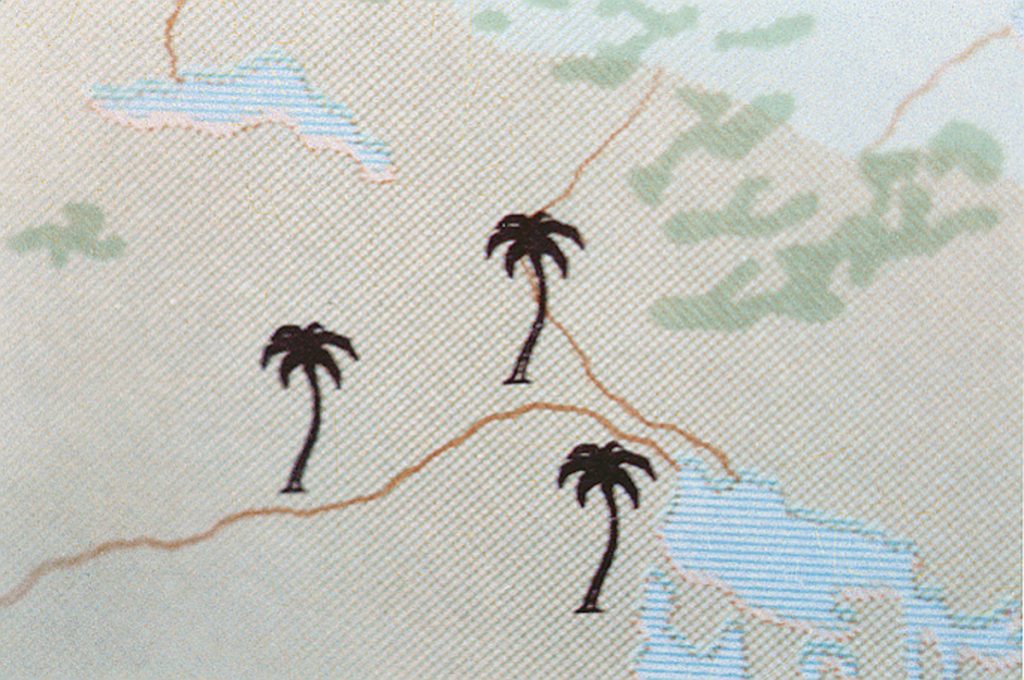
In Viaggio in Italia the Italian landscape presents itself in its primary elements: Ghirri selects the research and the structure of the project according to a thematic trend that has nothing to do with a geographical order or a travel journal (Giuliano Sergio). Authors and places are systematically mixed up, as if the various parts of Italy spoke the same language with different words and the authors too.
The most precious legacy of Viaggio in Italia, of Luigi Ghirri and all those photographers and intellectuals who, with him and around him, gave birth to what we now know as the “Italian landscape school”, was a new and, then – in the Eighties – very necessary vocabulary to describe the Italian landscape.
We are in 1984 and Luigi Ghirri’s idea of landscape is becoming more precise, just when the romantic and idealistic idea of landscape is dying. A few years later, in 1991, in a famous article published in “Casabella” Franco Purini says, in fact, that “the [Italian] landscape does not exist”. In its place there is an inhomogeneous collage, made up of layers of material, images and meanings, which, in order to be interpreted, needs new tools and names (Pippo Ciorra).
The photography of Ghirri and the other authors of Viaggio in Italia contribute in some way to the development of this new instrument.
The images question the fracture that has developed between contemporary man and the world that he himself has built. All these photographs constitute a document, but at the same time they are stripped of the condition of document for the approach with which they are made, far from documentary, for the reflections from which they arise and for their status as “simple observations” of places. In this paradox lies one of Luigi Ghirri’s greatest contributions to the exercise of awareness of the space we live in.
Photography, therefore, becomes a device capable of activating a thought, through which re-reading the landscape and the territory, tidying up the disorder of which Purini talks.
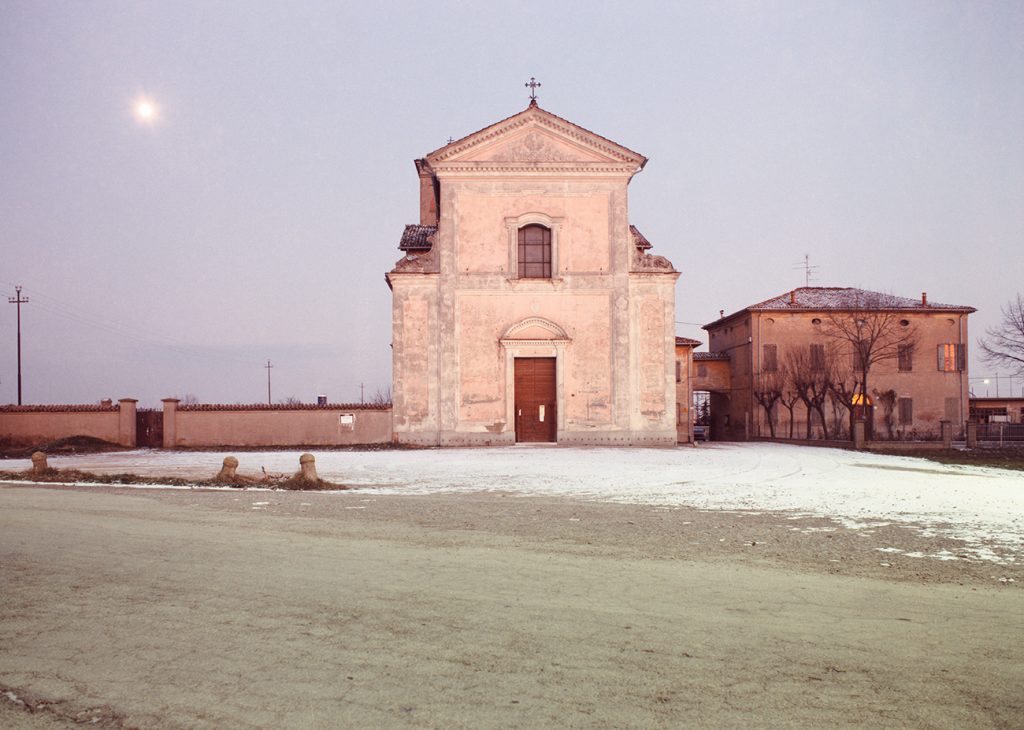
On the other hand, Italo Calvino, one of the intellectuals involved in that great choral and multidisciplinary project which is Esplorazioni sulla via Emilia, in the preface to Esplorazioni sulla via Emilia. Scritture nel paesaggio – published at the same time as the exhibition catalogue [Esplorazioni sulla via Emilia. Vedute del paesaggio, Feltrinelli, Milan, 1986] – states that we are all committed to “observing places, not in order to define, describe, classify them, but to help discover them, to look at them together, with many eyes, as if to reinforce the confidence in the possibility of transforming them.”
Esplorazioni sulla Via Emilia inaugurates a new photographic investigation process, linked to the idea of journey and exploration, which allows to discover or rediscover different aspects of reality through the photographer’s gaze. An approach that makes us think of that title that Guido Guidi chose for a meeting he held at the CRAF in Spilimbergo, “Photography is done with the feet”, which explicitly echoes the famous affirmation of the great urban planner Bernardo Secchi: “urban planning is built by feet.”
Remaining in Italy and gradually approaching our time, it is natural to focus on two projects that certainly owe a lot to Ghirri’s lesson and that draw unpublished maps of the places they visit through photographs.
Attraverso i villaggi (Through the villages,1986) is a project – and also a book – by Andrea Abati (Prato, 1952) who chooses the river Arno as the subject of his photographs. The journey from the source to the mouth of the river is, again, an adventure of thought and gaze and, here too, he draws an unpublished, unofficial map of the territories that follow the river on its way from the Casentino to the sea. Abati belongs to the generation following Ghirri’s, but he fits fully into that group of photographers who contributed to the definition of the “new landscape” and in his images he seeks, first of all, a reason for rethinking, a reflection on the territory. His photographs tell of abandoned areas and vestiges of modernity as well as intact spaces and remains of ancient grandeur: the river flows down the mountains, across the countryside, passes through villages and cities. Indifferently. It carries away the waste, overfloods, sweeps away.
In this work by Abati the river is what for Ghirri and his companions was the road and, in the same way, it tells not only about the places but also about their history, in a journey that is space, time, stratification, archive, montage.
In two years, Abati traveled the banks of the Arno in different stages, driven by a personal fascination for the river itself and the strong motivation to show the need to “improve” the quality of the water and the river environment. In those years, for example, many cities, including Florence itself, did not even have a wastewater treatment plant. What Abati’s images do, by recording without prejudice the history of the sedimentation of the territory, is to force us to look around us and trace in the intermittences of this new landscape the sign of the environmental and territorial transformations we have caused.
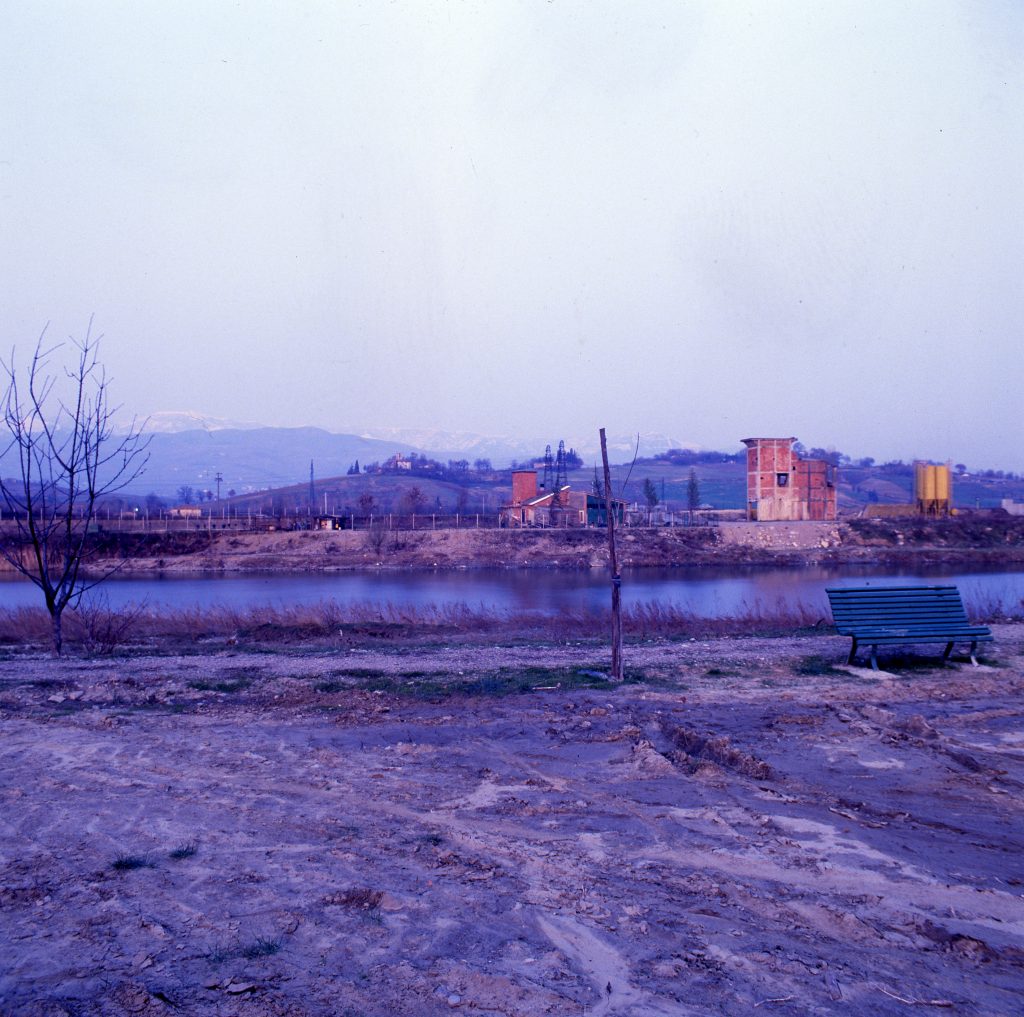
Around the walk is a collective project, a wandering laboratory, born from an idea of Ilaria di Biagio (Florence, 1984) and Pietro Vertamy (Cuneo, 1979) with the aim of creating new itineraries to be covered exclusively on foot, which can generate original and complex multidisciplinary narratives.
In their projects, photography seeks alternative perspectives to review the territory, and to do so – to broaden their gaze – it also uses the precious contribution of other disciplines, its traveling companions (topography, social sciences, music, other visual arts).
Lucania Walk in Progress (2015) has mapped a 200 km loop route in Basilicata, from Matera and back. The visual investigation is entrusted to Ilaria Di Biagio, who, with the medium format, has recorded sedimentation, unfinished business, remains of the landscape. Traveling on foot allowed her to discover those stratifications, especially infrastructural ones, which, are not visible from a car or staying on the main road.
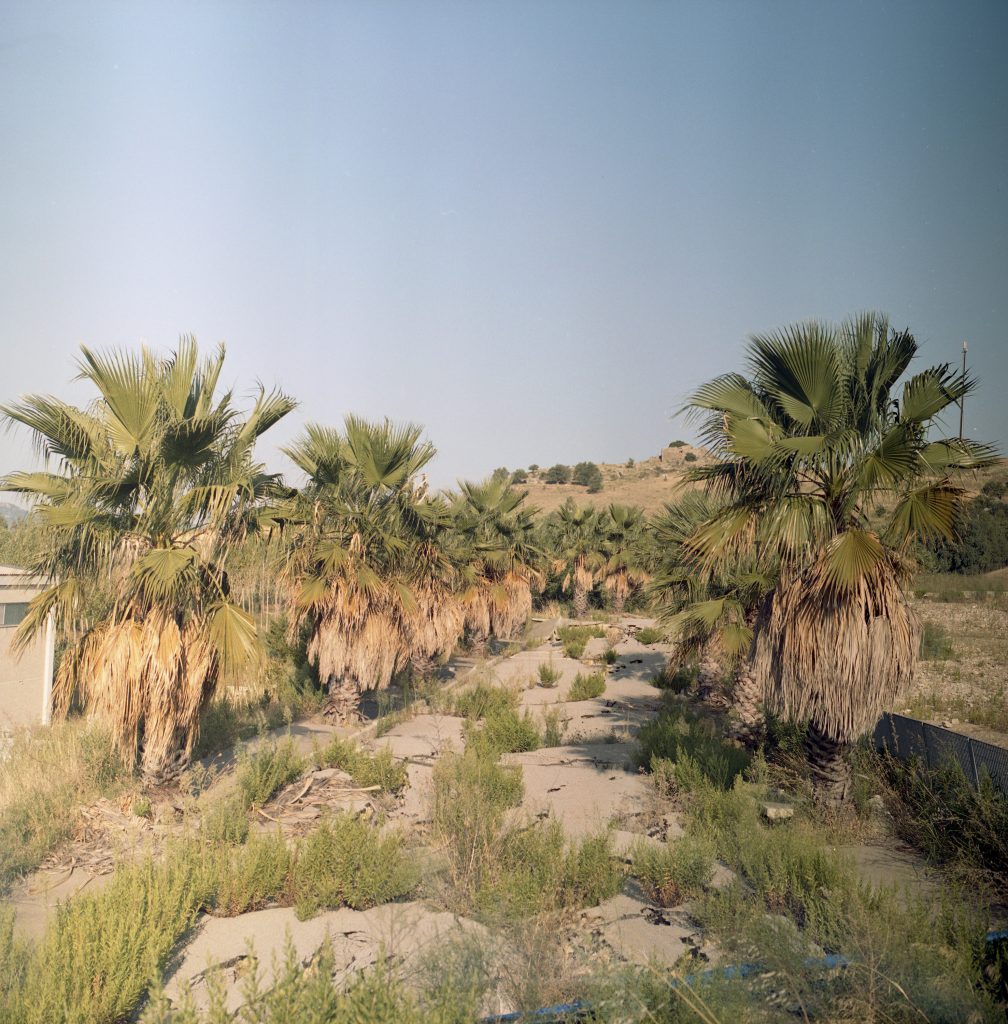
One of the most interesting stretches of the journey is the one between Ferrandina and Matera. The construction works of the Ferrandina-Matera La Martella railway line, which started in 1986, were never completed and the city of Matera today is still isolated from the rest of the national railway network, except for the narrow gauge line that connects it to Bari. The railway site, a 29 km long concrete strip, was entirely built, as were the civil works and the station buildings: the piling and armament, however, are completely missing. In Vertamy’s words, the amazement of the gaze: “It is bizarre to arrive here, after a journey of 200 km on foot in the midst of nature, walking on an endless strip of abandoned tarmac which should have become a railway. The Ferrandina-Matera railway line was in fact built and never opened. They didn’t put the tracks there. Two kilometers of gray tarmac remain, as landing strips for extraterrestrials. We also cross several iron bridges before arriving here and sitting down. Don’t get me wrong, for us travelers, it’s a beauty. Surreal, with plants that spring out of the cracks and foxes that run away on the road, fifteen meters above. The numbers, however, make the wrists tremble. Here is the Italian unfinished. The umpteenth. And laying there, as if that were not enough, Matera station. New, empty, abandoned.”
In the most recent of Around the Walk’s explorations, again, a river. Oltre Tevere is a path, a 405-kilometer journey through four regions and fifty-six Italian municipalities, traced and geo-referenced, which follows the great river Tiber that flows through Rome from its source to its mouth. Oltre Tevere is also, and above all, a visual investigation of a rich, fragile and precious territory, born thanks to the cooperation between Around The Walk and Associazione Phototales and Associazione Eternal Tiber. On the first page of his travel diary, Pietro Vertamy – who guided and accompanied five professional photographers along the entire journey – writes: “A river can be many things. School book teaching, in general, greatly restricts narrative options. An impassable natural barrier, but above all a source of life, resources and businesses for sensible people everywhere to build cities. […] As always, the observation point is crucial. The precise point in space, the height, the shooting range with which you decide to observe a portion of the world. And whether you want to put in front of your eyes some kind of filter or not, be it semantic or conceptual. What to frame and how, what to tell.”
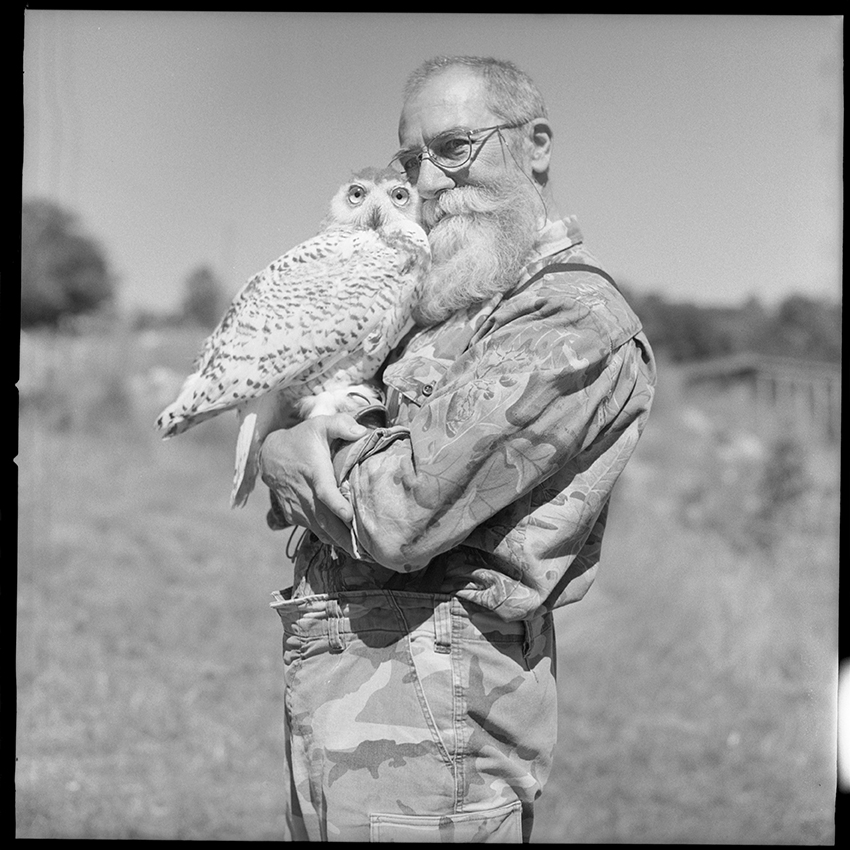
And therefore, fifty years after Atlante and almost forty years after Viaggio in Italia and Esplorazioni sulla Via Emilia, photography is still on the road, today as yesterday.
If photography is a journey, that is not in the terms usually suggested by this word, it is rather a traced itinerary but with many turns and returns, randomness and improvisation, a zig-zag line. [Se la fotografia è un viaggio non lo è nei termini classici suggeriti da questa parola, è piuttosto un itinerario tracciato ma con molti scarti e ritorni, casualità e improvvisazione, una linea a zig-zag.] Luigi Ghirri, from Un canto della terra. Intervista di Emanuela Teatini, in P. Costantini, G. Chiaramonte (edited by), Luigi Ghirri. Niente di antico sotto il sole, SEI, Turin, 1997
*This article is a review of the author’s speech L’avventura del pensiero e dello sguardo: inedite cartografie del paesaggio contemporaneo made during the 3 Giornate di Architettura (Pistoia, 9-11 June 2016) and published in Paolo Caggiano, Fabiola Gorgeri (edited by), Architettura e Percorso, 3 giornate di Architettura, V edizione, conference proceedings, Edifir, Florence, 2017. A special thanks goes to Fabiola and her delicate soul, for that precious and fruitful food for thought.
March 29, 2021




